|
Sunday:
September 28, 2003 | |
0630 GMT |
 |
Ariane trifecta: Moon probe, two other craft launched
Relying upon an experimental ion engine and miniaturized instruments, Europe's first robotic lunar orbiter has launched to study the Moon's history while serving as a technology testbed for future missions. The SMART 1 spacecraft shared the ride into space Saturday with two communications satellites aboard a European Ariane 5 rocket.
 FULL STORY FULL STORY
 MISSION STATUS CENTER MISSION STATUS CENTER
 |  |

|
 |
Sharpest ever color view of Mars captured by Hubble
This view of Mars, the sharpest photo ever taken from Earth, reveals small craters and other surface markings only about a dozen miles across. The Advanced Camera for Surveys aboard NASA's Hubble Space Telescope snapped this image just a few days before the red planet's historic "close encounter" with Earth.
 FULL STORY FULL STORY
 |  |

|
 |
|
Saturday:
September 27, 2003 | |
1150 GMT |
 |
Disaster monitoring craft among Kosmos 3M cargo
A cluster of small satellites rocketed into orbit today to embark on a wide range of missions for a number of organizations spanning the globe.
 FULL STORY FULL STORY
 |  |
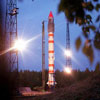
|
 |
Spy satellite launch delayed
The Japanese launch of two reconnaissance satellites was scrubbed Saturday due to troubles with the H-2A rocket, the Kyodo news agency reported. It said the mission would be rescheduled to "October 2 or later." The optical- and radar-imaging spacecraft will join two others launched into space earlier this year.
 WORLDWIDE LAUNCH SCHEDULE WORLDWIDE LAUNCH SCHEDULE
 COVERAGE OF EARLIER LAUNCH COVERAGE OF EARLIER LAUNCH
 |  |

|
 |
Ariane 5 rocket to loft three satellites today
In a change of pace for a team accustomed to almost one launch per month over the past decade, workers at Arianespace's South American launch site are preparing for just the fourth launch of 2003 for the company. Liftoff of the Ariane 5 rocket is set for 2302 GMT (7:02 p.m. EDT) today.
 MISSION STATUS CENTER MISSION STATUS CENTER
 LAUNCH EVENTS TIMELINE LAUNCH EVENTS TIMELINE
 |  |

|
 |
Paleontologist: New theory on dinosaur extinction
As a paleontologist, Gerta Keller has studied many aspects of the history of life on Earth. But the question capturing her attention lately is one so basic it has passed the lips of generations of 6-year-olds: What killed the dinosaurs?
 FULL STORY FULL STORY
 |  |
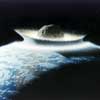
|
 |
|
Friday:
September 26, 2003 | |
0423 GMT |
 |
Hubble uncovers Uranus' smallest moons yet seen
Astronomers have discovered two of the smallest moons yet found around Uranus. The new moons, uncovered by NASA's Hubble Space Telescope, are about 8 to 10 miles across -- about the size of San Francisco.
 FULL STORY FULL STORY
 |  |

|
 |
New map of Milky Way shows galaxy to be cannibal
Chicken Little was right. The sky is falling. Thousands of stars stripped from the nearby Sagittarius dwarf galaxy are streaming through our vicinity of the Milky Way galaxy, according to a new view of the local universe constructed by a team of astronomers.
 FULL STORY FULL STORY
 |  |

|
 |
|
Thursday:
September 25, 2003 | |
0403 GMT |
 |
Waiting for a supernova
A team of European astronomers is using the Hubble Space Telescope to look back in time. They have imaged the spiral galaxy NGC 3982 and hundreds of other galaxies in the hope that one of the millions of stars in these images will some day explode as a supernova. They can then look back and pinpoint the exact star that has exploded. Only two such supernova 'mother stars' have ever been identified.
 FULL STORY FULL STORY
 |  |

|
 |
Ariane 5 rocket to loft three satellites Saturday
In a change of pace for a team accustomed to almost one launch per month over the past decade, workers at Arianespace's South American launch site are preparing for just the fourth launch of 2003 for the company. Liftoff of the Ariane 5 rocket is set for 2302 GMT (7:02 p.m. EDT) Saturday.
 MISSION STATUS CENTER MISSION STATUS CENTER
 LAUNCH EVENTS TIMELINE LAUNCH EVENTS TIMELINE
 |  |
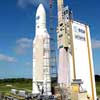
|
 |
U.S. production of RD-180 engines a major step closer
The move toward U.S. production of the RD-180 Russian rocket engine has taken a giant step forward, as four data packages were delivered in support of the U.S. Air Force Evolved Expendable Launch Vehicle/Lockheed Martin Atlas program. The complete engine documentation is now in the U.S. being translated, and the next step is to build key components at Pratt & Whitney located in Florida.
 FULL STORY FULL STORY
 |  |

|
 |
|
Wednesday:
September 24, 2003 | |
0057 GMT |
 |
NASA completes Orbital Space Plane design review
NASA's Orbital Space Plane program is one step closer to becoming the nation's next space vehicle with the successful completion of its Systems Requirements Review. The review evaluated the vehicle's concept design for providing crew rescue and transfer for the International Space Station.
 FULL STORY FULL STORY
 |  |

|
 |
Old telescope yields new Titan moon science
Meet Sarah Horst, throwback. The planetary science major, a senior at the California Institute of Technology, spent six months engaged in a bit of old-time telescope observing. The work led to some breakthrough research about Saturn's moon Titan, and indirectly led to funding for a new telescope at Caltech's Palomar Observatory.
 FULL STORY FULL STORY
 |  |

|
 |
Aerospace Safety Advisory Panel members resign
NASA Administrator Sean O'Keefe has accepted letters of resignation from all 11 members and consultants of the Aerospace Safety Advisory Panel. Congress first chartered the ASAP in the aftermath of the Apollo 1 fire in 1967 to act as an independent body to advise the NASA Administrator on the safety of operations, facilities and personnel.
 FULL STORY FULL STORY
 |  |

|
 |
IN OTHER NEWS Additional stories making news today
|
 |
NASA awards Deep Space Network operations contract -- NASA's Jet Propulsion Laboratory has awarded ITT Industries a five-year $274 million subcontract for operations and maintenance of NASA's Deep Space Network facilities in the United States and for support of overseas facilities. The DSN is an international network of antennas that supports interplanetary spacecraft missions. The network also supports selected Earth-orbiting missions.

NASA honors minority contractors -- NASA has named Zin Technologies, Inc., as Minority Contractor of the Year; Arcata Associates, Inc. as Minority Subcontractor of the Year; and Analytical Services, Inc. as Women Owned Business of the Year.
|
 |
|
Tuesday:
September 23, 2003 | |
0143 GMT |
 |
'Planet-swallowing' giant star identified
Astronomers have come forth with a solution to a mysterious new object recently discovered in our Milky Way. They suggest that this phenomenon is an expanding giant star swallowing nearby planets, an event which may one day befall our own planet.
 FULL STORY FULL STORY
 |  |

|
 |
Scientists practice Mars drilling near acidic river
To develop techniques to drill into the surface of Mars to look for signs of life, NASA and Spanish scientists recently began drilling into the ground near the source of the waters of the Rio Tinto, a river in southwestern Spain, part of a three-year effort that will include the search for underground life forms.
 FULL STORY FULL STORY
 |  |

|
 |
Telstar 4 a total loss
Loral Skynet says that it has been unable to re-establish contact with the Telstar 4 communications satellite and has declared the craft a total loss. As previously reported, Telstar 4 experienced a short circuit of its primary power bus last week.
 FULL STORY FULL STORY
 |  |
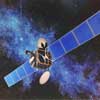
|
 |
|
Monday:
September 22, 2003 | |
0001 GMT |
 |
Galileo spacecraft crashes into Jupiter
One of the enduring and exciting episodes of the planetary exploration came to an abrupt end Sunday afternoon when NASA's battered Galileo spacecraft was crushed, melted and then assimilated into the planet Jupiter's all-embracing atmosphere. However, the 14-year mission leaves behind a rich legacy.
 FULL STORY FULL STORY
 SUNDAY'S ENTRY TIMELINE SUNDAY'S ENTRY TIMELINE
 TOP 10 SCIENCE ACHIEVEMENTS TOP 10 SCIENCE ACHIEVEMENTS
 |  |
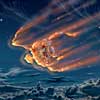
|
 |
The Galileo trials
If it were possible to label one day as "the worst" of spaceprobe Galileo's career, most scientists would choose Thursday, April 11, 1991. Ben Evans tells Galileo's chequered story.
 FULL STORY FULL STORY
 REVIEW OF GALILEO MISSION REVIEW OF GALILEO MISSION
 |  |

|
 |
Future Jupiter exploration on the drawing boards
The next mission to Jupiter will be revolutionary - a nuclear powered monster, a hundred times more capable than Galileo. Never before in space exploration has such a dramatic improvement in capability been encountered.
 FULL STORY FULL STORY
 |  |

|
 |

